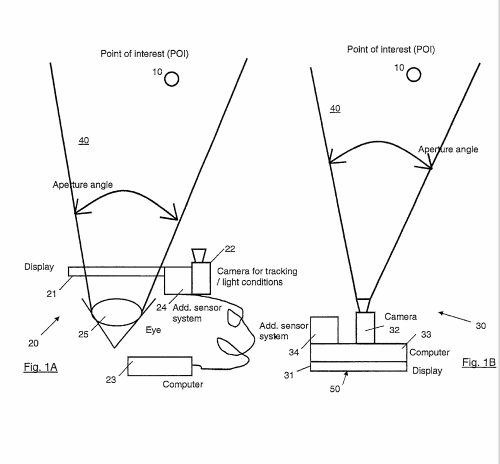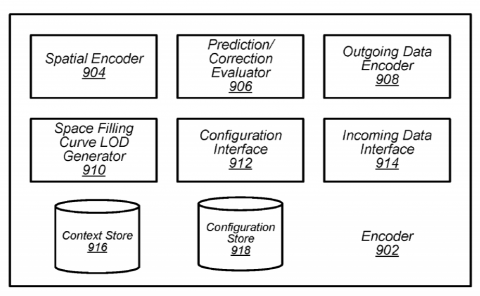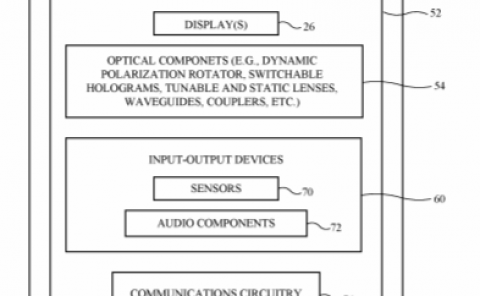Apple Patent | Method for determining the pose of a camera and for recognizing an object of a real environment
Patent: Method for determining the pose of a camera and for recognizing an object of a real environment
Publication Number: 10229511
Publication Date: 2019-03-12
Applicants: APPLE

Abstract
A method for determining the pose of a camera relative to a real environment includes the following steps: taking at least one image of a real environment by means of a camera, the image containing at least part of a real object, performing a tracking method that evaluates information with respect to correspondences between features associated with the real object and corresponding features of the real object as it is contained in the image of the real environment, so as to obtain conclusions about the pose of the camera, determining at least one parameter of an environmental situation, and performing the tracking method in accordance with the at least one parameter. Analogously, the method can also be utilized in a method for recognizing an object of a real environment in an image taken by a camera.
Background
Augmented Reality (AR) is a technology in which virtual data are overlaid with reality and which thus facilitates the association of data with reality. The use of e.g. mobile AR systems is already known in the prior art. In the past years, high-performance mobile devices (e.g. so-called smartphones) turned out to be suitable for AR application. These devices meanwhile have comparatively large color displays, installed cameras, good processors and additional sensors, such as e.g. orientation sensors and GPS. In addition thereto, the position of the device can be approximated via radio networks. In the past, there were various projects implemented on mobile devices using AR. At first, there were used special optical marks for ascertaining the position and orientation of the device. In more recent times, there are also approaches to utilize GPS and the orientation sensor systems of more modem devices. (AR Wikitude. http://www.mobilizy.com/wikitude.php.; S. Feiner, B. Macintyre, T. Hollerer, and A. Webster. A touring machine: Prototyping 3d mobile augmented reality systems for exploring the urban environment. In Proceedings of the 1st International Symposium on Wearable Computers, pages 74-81, 1997; Sekai Camera. http://www.tonchidot.com/product-info.html; Marko Heinrich, Bruce H. Thomas, Stefan Mueller, “AR Weather,” Mixed and Augmented Reality, IEEE/ACM International Symposium on, pp. 187-188, 2008 7th IEEE/ACM International Symposium on Mixed and Augmented Reality, 2008; layar.com).
However, it is noticeable in this regard that the registration, i.e. the accuracy of overlaying is worthy of improvement due to unsafe sensor data. An approach to this end is the use of hybrid tracking that improves initial poses of the camera from the combination of e.g. GPS, compass and gravitation sensors by optical approaches. Often, so-called “histogram equalization” of the image data is employed in order to reduce the susceptibility to varying light conditions.
Object recognition of a real object in an image taken by a camera and initialization of optical tracking systems for determining the camera pose relative to a real environment are known in the prior art. However, the reliability of the systems may occasionally vary greatly with varying environmental conditions. The camera pose in this regard is the position and orientation of the camera in space. The reality may be present e.g. in any form as data model, for example as 3D model describing the geometric properties of the reality or part of the reality.
The publication US 2003/0025714 describes a system visualizing weather data by means of augmented reality. The publication US 2005/0231419 A1 describes an AR system that monitors the airspace by means of weather-independent sensors and displays airspace information by means of AR.
Summary
It is the object of the invention to improve the robustness to changing environmental conditions in a method for determining the pose of a camera relative to a real environment and in a method for recognizing an object of a real environment in an image taken by a camera.
In accordance with a first aspect, the invention relates to a method for determining the pose of a camera relative to a real environment, said method comprising the following steps: taking at least one image of a real environment by means of a camera, the image including at least part of a real object, determining at least one parameter of an environmental situation, e.g. when taking the image, performing a tracking method that evaluates information with regard to correspondences between features associated with the real object and corresponding features of the real object as it is contained in the image of the real environment, in order to obtain conclusions about the pose of the camera, and performing the tracking method in accordance with the at least one parameter.
In accordance with a further aspect, the invention relates to a method for recognizing an object of a real environment in an image taken by a camera, said method comprising the following steps: taking at least one image of a real environment by means of a camera, the image including at least part of a real object, performing an image recognition method providing information with respect to the recognition of the at least one real object in the image, determining at least one parameter of an environmental situation, e.g. when the image is taken, and performing the image recognition method in accordance with the at least one parameter.
In particular, it is possible in this manner to recognize the current environmental situation and to configure the systems dynamically. By way of the matched configuration, the robustness with respect to changing environmental conditions is enhanced.
In accordance with an embodiment of the invention, the determination of the at least one parameter of the environmental situation is made using at least one or several of the following items of information: time of the day; time of the year; weather, in particular rain, clouds, sun (solar radiation) and fog; position of the moon; snow conditions; foliage of the trees; altitude above sea level; public events, in particular strong movements; traffic situation; position; orientation in a world coordinate system; histogram of the image; temperature; maintenance step. The at least one parameter of the environmental situation can be characteristic in particular for one or more of these conditions or situations.
Various environmental conditions, as pointed out in an exemplary manner hereinbefore, often have great influence on the aforementioned methods for object recognition and pose determination. When these conditions are recognized, it is possible to react accordingly. A reaction could be, for example, to prepare a data model of the environment for most of the positions of the sun, and to do so for rainy weather and sunny weather each. When it is desired to perform a recognition or initialization at a particular location, it is possible, e.g. by way of the time of the day/year and the query of online weather information, to load and make use of an appropriate data model (in which the angle between the vector of solar radiation and the vector of the calculated solar radiation is as small as possible). In general, there are thus one or more parameters measured, simulated or determined that describe at least part of the environmental conditions. It is possible to determine or derive from this one or more parameters which configure the recognition or initialization system for object recognition and pose determination, respectively.
In an embodiment of the invention, the tracking method employs at least one optical tracking method that is initialized in accordance with the at least one parameter.
For example, the pose of the camera is determined by means of the tracking method with one, two, three, four, five or six degrees of freedom.
In an embodiment of the invention, the tracking method can make use of several tracking sensors that are different with respect to the sensor type. For example, the tracking method includes weighing of at least one of the tracking sensors in accordance with the at least one parameter.
In an embodiment of the invention, the tracking method can also include a prioritization of method partial steps in accordance with the at least one parameter. However, it is also possible as an alternative or in combination therewith in a method making use of a data model that is compared with data of the image taken by the camera, to select the data model in consideration of the at least one parameter of the current environmental situation. In a further embodiment, there is used at least one data model that is compared with data of the image of the real object in the image of the real environment, with the at least one parameter having influence on the preparation and/or the use of the data model.
For example, the at least one parameter has influence on the kind of preparation of the data model, in particular the preparation of so-called feature detectors and descriptors. In a further embodiment, a data model is extracted from a number of individual models which were recorded with the at least one parameter (environmental situation) or prepared by simulation, the data model containing an intersection of items of information that are present in several environmental situations.
The invention also relates to a method for providing a data model that is intended to be compared with data of an image taken by a camera in a method for determining the pose of a camera relative to a real object of a real environment or in a method for recognizing an object of a real environment. In accordance with such a method, an environmental situation is ascertained or simulated, and at least one parameter of the environmental situation is determined. Furthermore, there is prepared a data model containing a basic description of the real object, various environmental situations are set or simulated and, for different environmental situations, a respective matched data model is provided in accordance with the respective at least one parameter (this can take place e.g. as a direct reaction on the current parameters or as a reserve, e.g. when most of the situations are to be simulated in advance).
According to an embodiment, the basic description is a virtual 3D model of an environment.
According to a further embodiment, a data model is prepared that contains an intersection of items of information that are present in several different environmental situations.
For example, when virtual information is blended into a view of a real environment, weather data can be considered which are retrieved e.g. via the Internet (“online”) in order to increase the degree of reality of blended in virtual information with respect to the real environment and thus improve association. There are various degrees of complexity conceivable here for processing. For example, on the basis of the weather situation, there may be assigned fixed lighting models or materials (e.g. textures) matched to the weather situation. In accordance with the weather data (such as e.g. clouds, solar radiation etc.) and/or other data (such as e.g. time of the day/year etc.), shadows cast or light conditions can be calculated (e.g. by the raytracing method known to those skilled in the art).



